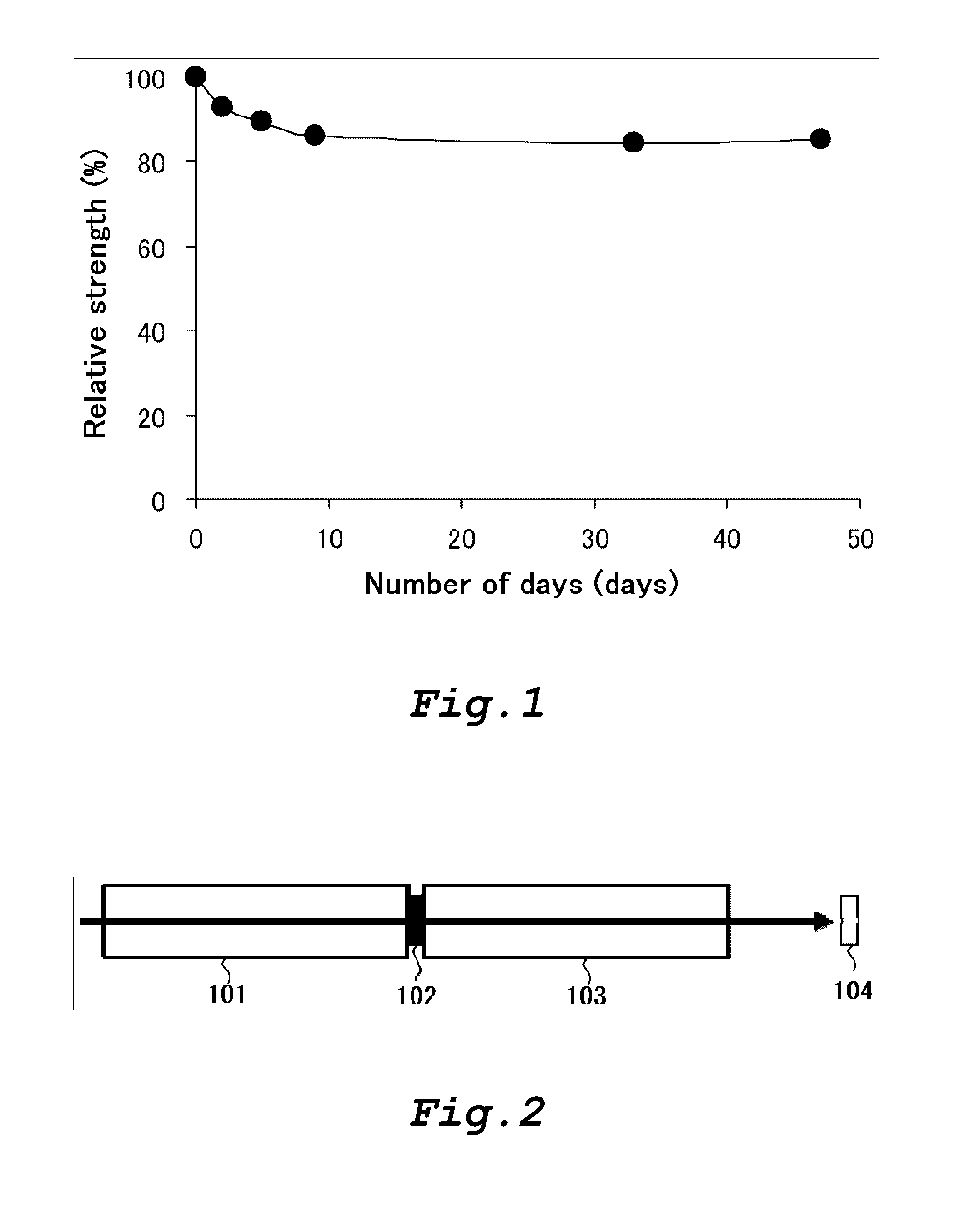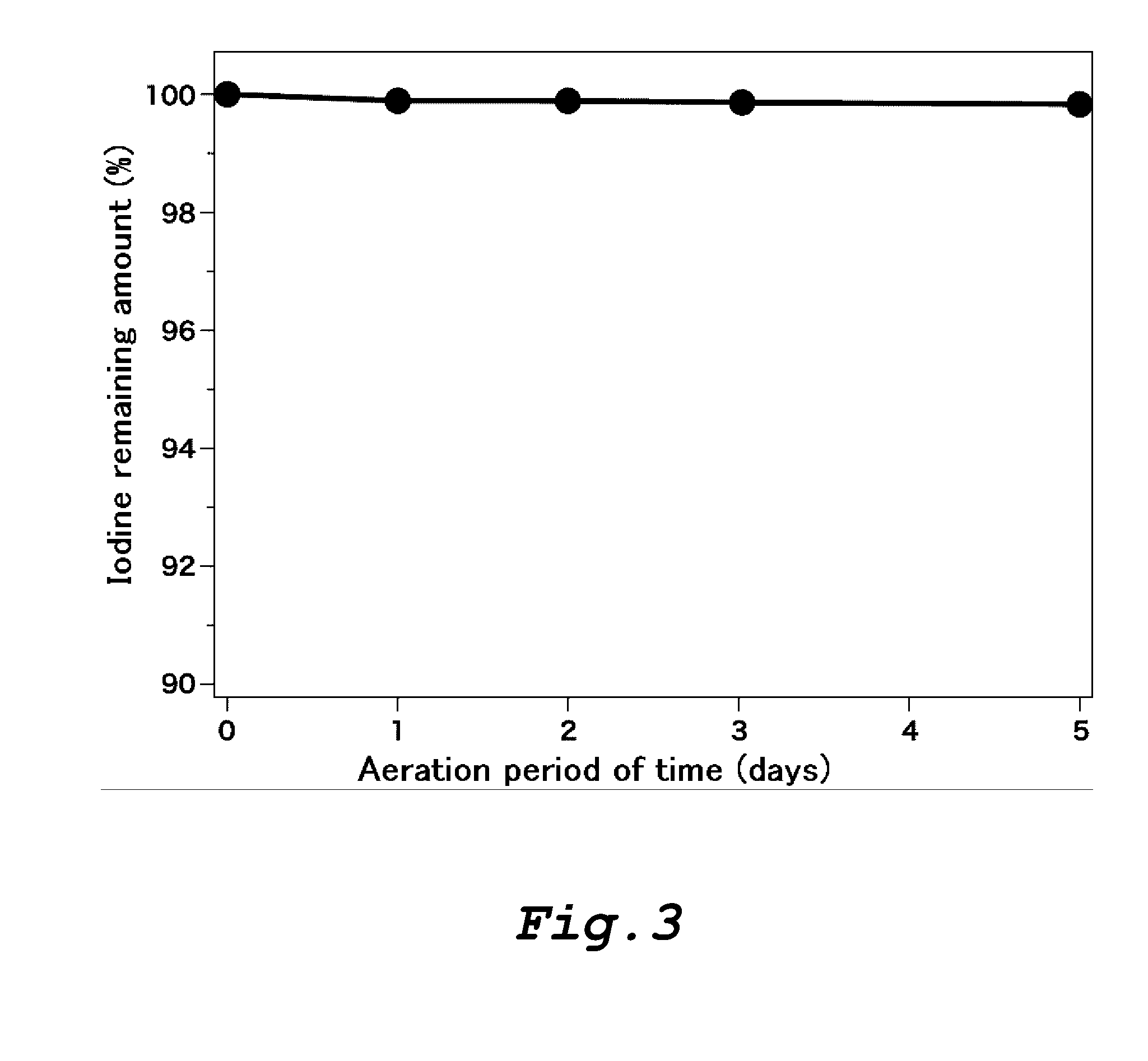Iodine- and amylose-containing fibers, method for production thereof, and use thereof
a technology of amylose and fibers, which is applied in the field of amylose-containing functional rayon fibers, can solve the problems of inability to achieve the effects unable to achieve the effect of reducing the number of amylose-containing fibers, and achieving excellent microbiocidal and deodorant functions, the effect of efficient recovery of iodine from brin
- Summary
- Abstract
- Description
- Claims
- Application Information
AI Technical Summary
Benefits of technology
Problems solved by technology
Method used
Image
Examples
synthetic example 1
Synthesis of Amylose
[0226]Thermostabilized glucan phosphorylase derived from potato tuber, prepared and purified according to the method described in Example 2-1A in International Publication No. WO 2004 / 113525 pamphlet (glucan phosphorylase with the amino acid sequence of SEQ ID NO: 34 described in International Publication No. WO 2004 / 113525 pamphlet; 1 unit / mL), and thermostabilized sucrose phosphorylase derived from Streptococcus mutans, prepared according to the method described in Example 2A in International Publication No. WO 2005 / 24008 pamphlet (sucrose phosphorylase with the amino acid sequence of SEQ ID NO: 22 described in International Publication No. WO 2005 / 24008 pamphlet; 1 unit / mL) were added to a reaction liquid (1 Liter) containing 20 mM phosphate buffer (pH 7.0), 20 g / L of sucrose and various concentrations of a malto-oligo saccharide mixture (3,880, 232, 77, 44 or 8.8 mg / L), and this was incubated at 37° C. for 16 hours. After completion of the reaction, the weigh...
examples 1-1 to 1-4
and Comparative Examples 1-1 to 1-4
Production of Amylose-Containing Rayon Fiber
[0232]Viscose was prepared from a raw material pulp (LDPT manufactured by Nippon Paper Chemicals Co., Ltd.) according to a conventional method. In this viscose, the cellulose content was 9% by weight, the alkaline content was 5% by weight, and the falling ball viscosity was 60 seconds.
[0233]Each of the enzymatically synthesized amylase having an average molecular weight of 5.2×103, 4.62×104 or 1.174×105 (containing no branch structure), prepared in Synthetic Example 1, was dissolved in an aqueous 5% by weight NaOH solution, to prepare an aqueous alkaline solution of amylose. Any of these aqueous alkaline solutions and viscose were mixed according to a conventional method, followed by spinning, to give amylose-containing rayon fibers. Control rayon fibers were obtained by spinning the viscose alone, without mixing it with the aqueous alkaline solution (Comparative Example 1-1). Wherein, amylose was charged...
example 2
Evaluation on Ability of Amylose-Containing Rayon Fibers to Form a Clathrate
[0237]The ability of the amylose-containing rayon fibers produced in Examples 1-1 to 1-4 to form a clathrate and the ability of the control rayon fibers produced in Comparative Examples 1-1 to 1-3 to form a clathrate were measured using nonyl phenol as a guest substance.
[0238]The amylose-containing rayon fibers produced in Examples 1-1 to 1-4 and the control rayon fibers produced in Comparative Examples 1-1 to 1-3 were respectively impregnated with nonyl phenol by immersing 50 mg of each rayon fibers in 3 mL of an aqueous 50% methanol solution containing nonyl phenol in a concentration of 100 ppm at 25° C. for 3 hours. The concentration of nonyl phenol in the aqueous solution was measured on liquid chromatography before and after immersion of the rayon fibers.
[0239]The conditions of liquid chromatography were as follows.
[0240]TSKgel ODS-100Z (manufactured by TOSOH CORPORATION) was used as a column, a UV dete...
PUM
| Property | Measurement | Unit |
|---|---|---|
| Percent by mass | aaaaa | aaaaa |
| Percent by mass | aaaaa | aaaaa |
| Fraction | aaaaa | aaaaa |
Abstract
Description
Claims
Application Information
 Login to View More
Login to View More - R&D Engineer
- R&D Manager
- IP Professional
- Industry Leading Data Capabilities
- Powerful AI technology
- Patent DNA Extraction
Browse by: Latest US Patents, China's latest patents, Technical Efficacy Thesaurus, Application Domain, Technology Topic, Popular Technical Reports.
© 2024 PatSnap. All rights reserved.Legal|Privacy policy|Modern Slavery Act Transparency Statement|Sitemap|About US| Contact US: help@patsnap.com










